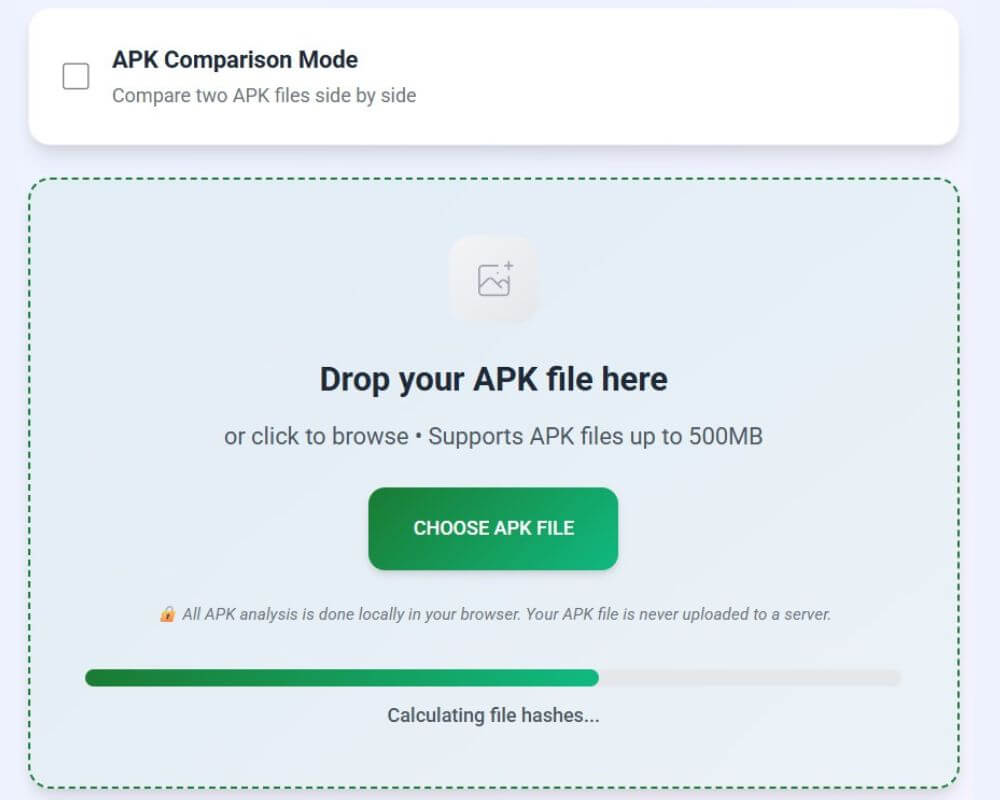You’re holding a sideloaded APK. It could be a modded app, a region-locked tool, or something banned from the Play Store. But before you hit install, here’s the real question: what exactly are you putting on your phone?
Most people don’t check. They assume an APK that opens is clean. But what matters isn’t what it looks like—it’s what it’s built to do. And if you’re not inspecting it locally, you’re just hoping it won’t burn you.
The Most Dangerous APKs Look Completely Normal
They don’t flash malware alerts. They don’t crash your phone. They ask for just enough access to watch you from the background. And they hide in plain sight.
Some mimic calculators. Others clone popular tools with fake package names. Most are signed with generic keys, stripped of developer info, and repacked with injected ad SDKs or trojans. You tap install, it runs fine—and meanwhile, it’s uploading contacts, grabbing location data, or listening to clipboard events.
This isn’t theory. It’s normal. Dangerous apps survive because they don’t trigger obvious red flags. They ask politely. And users don’t ask anything back.
What the Basic Checks Catch and What They Can’t
Start at the surface:
- Is the source known and developer information listed? If you pulled it from a random Discord, Telegram, Google Drive, or group chat, don’t assume anything.
- Does the app request more than it should? A flashlight that wants GPS, or a wallpaper app that needs microphone access, doesn’t add up.
- Can you verify the file hash on VirusTotal? Paste the SHA-256 hash — not the file — and check for known malware signatures or detection flags. This alone can catch recycled or flagged variants.
But these checks only spot the obvious. They won’t show obfuscated payloads, code injections, or dangerous components. For that, you need static analysis—done offline.
How Real APK Analysis Works
A proper inspection like our APK Analyzer handles APKs up to 500MB with precision. It runs on your device, inside your browser, never touches a server, and digs deeper than antivirus scans ever will.
Certificate Inspection
Every APK is supposed to be signed. A good analyzer checks that signature against Android’s schemes—v1, v2, v3. It flags test keys, mismatched certificates, and debug builds. You’ll know immediately if the APK was tampered with or self-signed after repacking.
Manifest Breakdown
Inside every APK is an AndroidManifest.xml. It defines launchers, permissions, and export settings. Rebuilding it shows which services or activities are exposed—and whether anything dangerous is silently declared. If the app launches background services without requiring permissions, that’s not an oversight. It’s a trap.
Permissions Grouped by Risk
You’ve seen permission lists before—but not like this. A smart scan shows which ones matter. It links combinations: location + network + installed app visibility = profiling. Audio + overlay + boot receiver = potential spyware. It’s not about the number of permissions—it’s what they enable together.
DEX and Code Mapping
Every line of app logic lives in .dex files. A bloated DEX count on a tiny app means something’s off. If a 2MB APK holds 18,000 methods and a thousand string constants, it’s not a calculator—it’s hiding something. Add encrypted strings or obfuscated function names, and the risk triples.
Native Code Detection
Embedded .so libraries run below Android’s permission layer. An analyzer should list all native files, their target architectures (ARM64, x86), and flag anything unnecessary. If your emoji keyboard ships with a dozen native binaries, ask why.
Exported Component Mapping
Exported components are the exposed surfaces. If activities, services, or broadcast receivers are marked as exported without permission restrictions, they can be triggered remotely. Many malware apps use these as backdoors—waiting for an intent to activate them.
Tracker and SDK Identification
Third-party SDKs get bundled with good apps and bad ones. Some are just ad networks. Others have histories of abuse or vulnerabilities. Static inspection flags embedded libraries, names their functions, and matches them to known CVEs when relevant. Even legit apps get sloppy.
Report Export and Build Comparison
Every inspection should end with a report. TXT, JSON, or PDF—it doesn’t matter. What matters is traceability. You should be able to compare two builds, see what changed, and verify if that new update added more than just bug fixes.
Actual Red Flags That Demand Attention
Not all issues are subtle. Here’s what should stop an install immediately:
- The APK is signed with a debug certificate
- The app exports all components without any protection
- DEX count exceeds 15,000 methods on a 3MB file
- Multiple .so libraries exist with no clear function
- Query_All_Packages + GPS + microphone + clipboard access — for a non-utility app
- Tracker SDKs with known CVEs embedded in an otherwise basic app
These aren’t anomalies. They’re patterns. And they show up in real-world scans every day.
Sideloading Without Inspection Is Like Running Root Without Logs
You don’t need root to get burned. And tools like LSPatch, XPrivacyLua, or AppOps help—but only after the app is live. Once permissions are granted and services run, there’s no going back.
Prevention is stronger than containment. And static analysis gives you the full picture before install.
The Play Store isn’t perfect. But sideloading safely means replacing its filters with your own. You don’t need to guess anymore. You just need to look.
If you downloaded an APK today—would you bet your contacts, camera, and clipboard it’s clean?
Or would you check?

